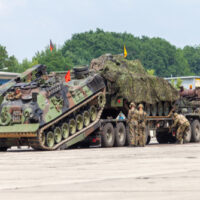Belgium (Brussels Morning Newspaper) Germany, Denmark and the Netherlands will join forces to provide Ukraine with more than 100 older Leopard 1 tanks in a new initiative separate from the NATO allies’ plans to provide Leopard 2 tanks to Kyiv.
The three countries announced their latest initiative in a joint statement published on Tuesday, stating that the older tanks will come from existing industry stocks, and that the partners involved would pool resources to refurbish, rearm and equip the tanks, as well as secure the necessary training, spare parts and ammo Ukraine will need to make use of the older Leopards.
German Defense Minister Boris Pistorius, making a surprise visit to Kyiv, announced that the first batch of Leopard 1 tanks should reach Ukraine by summer this year, between 20 and 25 tanks, while around 80 tanks should be delivered by the end of the current year altogether. According to a statement by Ukrainian Defense Minister Oleksii Reznikov’s office, more than 100 should arrive in 2024.
The Leopard 1 was designed and produced by the West German company Krauss-Maffei between 1965 and 1984, when it was slowly to be phased out by its successor, the Leopard 2. At the time of its inception, it was one of the most advanced and most mobile tanks in the world, designed with weaker protection but higher mobility in mind, coupled with effective firepower.
The models that the three countries plan to send to Ukraine are based on a late upgrade, the 1A5 version, introduced in the early 1980s, which introduced modernised fire control systems, an effective night vision/all-weather system, and a bolt-on polycarbonate armour, which significantly strengthened the tank’s protection.
Serious threat
The Leopard 1A5 version, while obsolete by modern standards of western tanks, can still pose significant threat to Soviet-era tanks fielded by the Russian forces in Ukraine, which now comprise the majority of their armoured units in the country. At the same time, it still offers excellent mobility which would help Ukraine utilise it as an effective cavalry force, screening for openings, conducting reconnaissance in force and rushing to exploit opportunities created by other units.
“It’s really a tested tank”, said Dutch Defence Minister Kasja Ollongren on Tuesday. “They’re being fixed and made battle-ready, so they will definitely be useful for the Ukrainians, and also better than a number of Russian tanks”.
Speaking for the public broadcaster NOS, Ollongren stressed that the Leopard 1 was “definitely still suitable” for combat use despite being an older model. Germany, Denmark and the Netherlands also noted that the initiative is open to other countries that wish to join, with Belgium reportedly showing interest.
More than 4,700 Leopard 1s were made during its production run, with additional 1,741 utility and anti-air vehicles sharing the same chassis, such as the German Gepard self-propelled anti-air guns, which Berlin had previously delivered to Kyiv. While some countries still keep Leopard 1 tanks in active service, such as Greece, Turkey, Brazil and Chile, many other European countries keep them in reserve in diverse states of repair.



